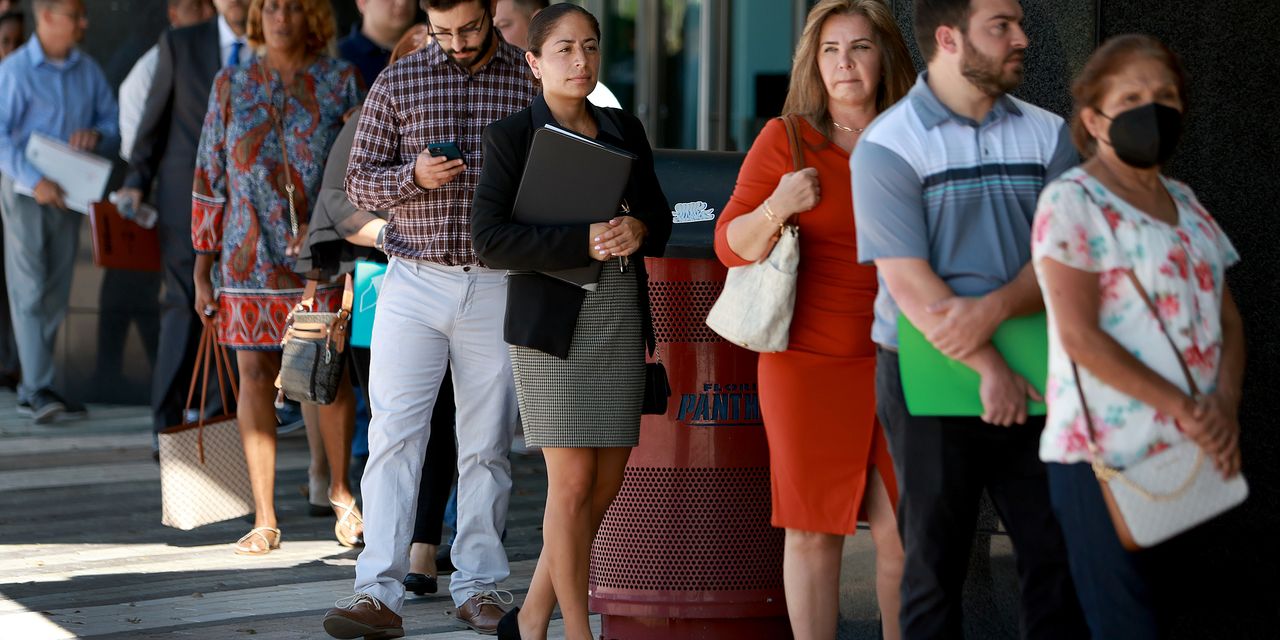It’s been a full year since one of the U.S. bond market’s most reliable gauges of impending recessions started to consistently flash worrisome signals, and yet no downturn has materialized.
Instead, investors and traders are now increasingly hopeful about a soft landing, or scenario in which inflation continues to ease without a meaningful uptick in unemployment or a recession — raising doubts about the credibility of the Treasury market’s pessimistic message over the past 12 months.
Read: Goldman chief economist sees reduced chance of recession and dismisses inverted-yield-curve worries
Amid the continuing debate about whether the world’s largest economy will or won’t fall into a contraction lasting two consecutive quarters, strategist Jim Reid of Deutsche Bank weighed in via a Wednesday note with the view that the window in which a U.S. downturn could still happen actually runs through next February. That’s based on how historical lags between U.S. recessions and an inverted spread on 2-
TMUBMUSD02Y,
and 10-year Treasury yields
TMUBMUSD10Y,
have played out over the past seven decades.
An inverted curve simply means that the policy-sensitive 2-year rate is trading far above its 10-year counterpart, as it is now because of the Federal Reserve’s battle against inflation. The yield on the 10-year Treasury note finished about a full percentage point, or 100 basis points, below the yield on the 2-year note on Wednesday.
Reid describes the 2s10s spread, which has remained consistently below zero since last July, as “the most accurate predictor of a U.S. downturn over the last 70 years.” In other words, no domestic recession has ever occurred without an inverted curve occurring first, and there’s been only one false alarm which took place in the mid-1960s.
Historical lags — starting from the time when the 2s10s spread goes below zero, and stays there for three months, to when a recession comes to fruition — suggest that the U.S. economy could still fall into a downturn sometime between now and early next year, according to Reid.
His Chart of the Day shows that a U.S. recession next January or February could occur using the same historical lags seen during downturns in January 2008 and August 1990.
“We’re around a third of the way” through the window which opened in March and closes next February for a possible U.S. recession, as suggested by patterns which have played out over nine of the past 10 cycles, Reid wrote. “The closer we get to the end of the first quarter next year without a recession, the more the chances of this time being different. Until then, we’re playing dodgeball.”
Indeed, analysts like those at Swiss banking giant UBS are focusing on the flip side of the recession argument, by outlining all of the reasons a U.S. downturn hasn’t happened yet. They cite strong consumer savings, a resilient job market, and monetary policy by the Federal Reserve which is still not tight enough as a few of the factors holding up the U.S. economy.
Frankfurt-based Deutsche Bank is often regarded as Wall Street’s most pessimistic bank. In April of last year, it became the first major bank of the current inflation era to predict a U.S. recession and a growth recession in the euro area within the next two years.” The latter scenario has since occurred, with the eurozone falling into a technical recession earlier this year.
On Wednesday, the 2s10s spread ended the New York session at minus 101.2 basis points. Treasury yields finished mostly lower after softer-than-expected U.K. inflation data. Meanwhile, Dow industrials
DJIA,
and the S&P 500
SPX,
closed higher, extending their year-to-date gains. And the ICE U.S. Dollar Index
DXY,
a reflection of investors’ views about the U.S. outlook relative to other countries, jumped 0.4%.
The only false alarm produced by an inverted 2s10s curve and cited by Reid was in the mid-1960s “when, due to rising inflation, the market was expecting a hiking cycle in 1966 that didn’t materialize” partly because of a falling equity market and concerns about rising unemployment.
As a result, the curve eventually moved back above zero and “the looser policy than expected helped avoid a recession,” Reid said. “However, inflation reignited in 1967 and the Fed had to hike more aggressively later in the decade and the next inversion in 1968/69 restored the usual lag between inversion and recession,” which was formally declared by the National Bureau of Economic Research as starting in December 1969.
Read the full article here



